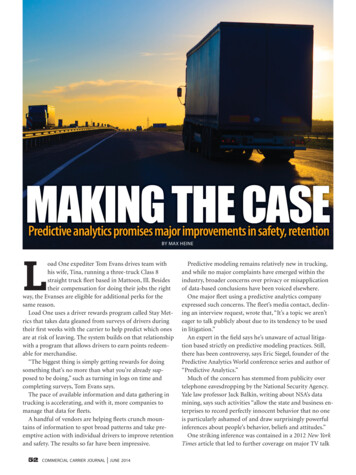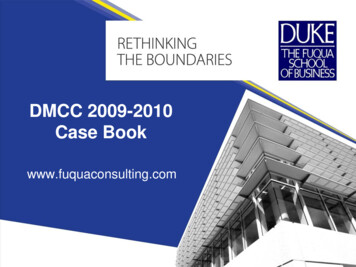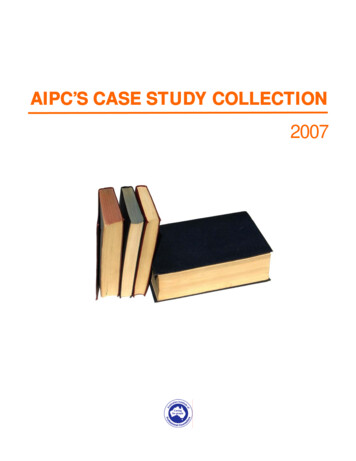
Transcription
MAKING THE CASEPredictive analytics promises major improvements in safety, retentionBY MAX HEINELoad One expediter Tom Evans drives team withhis wife, Tina, running a three-truck Class 8straight truck fleet based in Mattoon, Ill. Besidestheir compensation for doing their jobs the rightway, the Evanses are eligible for additional perks for thesame reason.Load One uses a driver rewards program called Stay Metrics that takes data gleaned from surveys of drivers duringtheir first weeks with the carrier to help predict which onesare at risk of leaving. The system builds on that relationshipwith a program that allows drivers to earn points redeemable for merchandise.“The biggest thing is simply getting rewards for doingsomething that’s no more than what you’re already supposed to be doing,” such as turning in logs on time andcompleting surveys, Tom Evans says.The pace of available information and data gathering intrucking is accelerating, and with it, more companies tomanage that data for fleets.A handful of vendors are helping fleets crunch mountains of information to spot broad patterns and take preemptive action with individual drivers to improve retentionand safety. The results so far have been impressive.52COMMERCIAL CARRIER JOURNAL JUNE 2014Predictive modeling remains relatively new in trucking,and while no major complaints have emerged within theindustry, broader concerns over privacy or misapplicationof data-based conclusions have been voiced elsewhere.One major fleet using a predictive analytics companyexpressed such concerns. The fleet’s media contact, declining an interview request, wrote that, “It’s a topic we aren’teager to talk publicly about due to its tendency to be usedin litigation.”An expert in the field says he’s unaware of actual litigation based strictly on predictive modeling practices. Still,there has been controversy, says Eric Siegel, founder of thePredictive Analytics World conference series and author of“Predictive Analytics.”Much of the concern has stemmed from publicity overtelephone eavesdropping by the National Security Agency.Yale law professor Jack Balkin, writing about NSA’s datamining, says such activities “allow the state and business enterprises to record perfectly innocent behavior that no oneis particularly ashamed of and draw surprisingly powerfulinferences about people’s behavior, beliefs and attitudes.”One striking inference was contained in a 2012 New YorkTimes article that led to further coverage on major TV talk
ees from leaving. Siegel reportsshows. The story described howthe program has had modestTarget uses not only baby regsuccess at HP.istration data but also purchasStill, there can be problems,ing data to direct its marketingas he points out: “What if yourefforts to women it believes arescore is wrong, unfairly labelingpregnant.you as disloyal and blemishingThe story, with “a tone thatyour reputation?”implies wrongdoing,” wroteHere the application toSiegel in his book, “punctuatestrucking is more direct. Withthis by alleging an anonymousstory of a man discovering hisLoad One expediter Tom Evans drives team with his wife, turnover rates so high, predicTina, running a three-truck Class 8 straight truck fleettive analytics could become ateenage daughter is pregnantbased in Mattoon, Ill. By simply doing their jobs, Loadonly by seeing Target’s marketmajor tool.One’s Stay Metrics program allows the Evanses to earnSo far, predictive analytics’ing offers to her.”points redeemable for merchandise.use in human resources largelyIn trucking, the impetus touse predictive analytics isn’t to sell products, but rather tohas held to the high road, say Siegel and those involved withit in trucking.show whether a driver is about to leave the company or“We’re not peering into drivers’ personal lives,” says Vikashave an accident.Jain, general manager of FleetRisk Advisors. “We’re notAs for improving safety, whether in trucking or any field,accessing any data the fleet doesn’t already have. We areethical concerns “are few and none,” says Siegel. “There’s ahelping the driver.”lot of potential to do a lot of good.”Still, the process can involve identifying driver stressesBut when it comes to concerns over companies usingthat are unrelated to trucking. However, no major comdata to reveal personal problems that could affect loyaltyplaints stemming from fleets using predictive modelingor performance, “There are places where the world is nothave come from members of the Owner-Operator Indepencomfortable with that yet,” he says.dent Drivers Association, says spokesman Norita Taylor.Perhaps the most publicized human resources applicaHere is a look at three vendors with varied approaches totion of predictive analytics involves Hewlett-Packard. In2011, two HP scientists analyzed data on more than 330,000 the same problems and serving differing niches of fleets bysize. They are leaders in helping fleets use data, to varyingcompany employees to measure each one’s “flight risk,” ordegrees with predictive modeling, to improve retention,chance of quitting.safety or both.The intention is to help managers prevent good employ-FLEETRISK ADVISORSMARKETED AS: Predictive analyticsEMPHASIS: Safety, retention and workers compDATA USED: Extensive trucking data, such as drivers’ starting times orchange in empty miles relative to fleet averageTARGET CUSTOMERS: Fleets of 500-plus trucksAunit of Omnitracs, FleetRisk Advisors positions itself explicitly as a vendor of predictive analytics, and a good one: Itreceived the IBM Business Analytics Excellence award in the ROIAchievement category in 2013.The FleetRisk model uses a broader data set to spot patternsthat can be more accurate than what fleets traditionally havepredicted using more simplistic analysis, says Jain.Every fleet uses some version of “scorecarding,” says Jain,“where the fleet creates a set of attributes” such as hard-brakingevents or violations. “They also try to make an extrapolation thatif they’re not performing well, they’re probably at a higher risk.”However, FleetRisk’s analyses show insufficient correlationthere. Likewise, the company has foundlittle correlation between accident risk andrelated data generated by the federal Compliance Safety Accountability program.“What we do is gather 1,500 to 2,000data points from fleets,” says Jain. Thatincludes not only driver performance data,but also operational data such as telemetDavid Broyles,rics, driver start times and variances inoperations managerfor Averitt Express,driver schedules, pay and miles.says the fleet hasA fleet client can check its website acfound retention tobe a “byproduct”count “to review a list of drivers most likelyof using FleetRiskto have a preventable accident, voluntaryAdvisors’ safetymodule.turnover, or workers comp claim in thenext 28 days,” says the FleetRisk website.Managers typically then would hold a 15- to 20-minute remediation talk with each driver on that list, Jain says. “Not to addressthe issue necessarily, but to assure them the fleet is there to supCOMMERCIAL CARRIER JOURNAL JUNE 2014 53
C OV E R S T O RY: P R E D I C T I V E A N A LY T I C SAveritt Express is usingFleetRisk for the 1,300to 1,400 trucks in itstruckload division andthe 700 in its dedicateddivision.port him through his challenges.”It’s common to find certain behaviors point to a driver stressedfor a personal reason – a pregnant wife, a sick child or a pendingdivorce. The solution is to decrease the stress, Jain says, by helpingthe driver manage that situation, whether through counseling orother means, and not to punish him.One fleet customer talked with a driver who appeared to beat risk and discovered that his wife of 40 years had died. He keptdriving “just to keep his mind off things,” but had not come toterms with the death, Jain says. The fleet gave him a week of paidleave.The system also helps fleets in that they “don’t have the time orresources to call all drivers every few months or weeks,” says Jain.“We’re able to help them talk to the right driver at the right timeon the right subject.”FleetRisk says every one of its customers has seen retentionincrease. That’s true even for those who use only FleetRisk’s safetyapplication “because drivers now feel connected,” says Jain.When fleets remediate with the 10 percent of drivers most atrisk for an accident, those drivers have post-remediation accidentrates that are 85 percent lower than what the remaining 90 percent of drivers experience, FleetRisk says.The cost is 6 per month per driver for each of the three models: safety, workers comp and retention.CASE STUDY: Averitt ExpressIn its six years of working with FleetRisk, Averitt Express hasmade big improvements in safety, says David Broyles, operationsmanager. The Cookeville, Tenn.-based company is using FleetRiskfor the 1,300 to 1,400 trucks in its truckload division and the 700in its dedicated division. In the last three years alone, Averitt’struckload division has seen a 41 percent drop in preventable accidents.The fleet is using only FleetRisk’s safety module but has foundretention to be a “byproduct” of that effort. With the advent ofQualcomm years ago, Averitt, like many fleets, “quit using the telephone like we used to,” says Broyles. “You lose that relationshipbuilding with drivers.”Now, when the data identifies at-risk drivers in need ofremediation, “We’re forcing the fleet manager to get back in the54COMMERCIAL CARRIER JOURNAL JUNE 2014business of talking to drivers on the phone,”says Broyles.Averitt started with identifying the 10percent of drivers most likely to be facingan accident in the near future. As the accident rate dropped for that group, managersbegan addressing the top 30 percent.Some typical predictors at Averitt havebeen financial stress, accidents in the past90 days, and the frequency of workingmidnight to 5 a.m. in the past two weeks.Broyles says some “curious” predictors also have emerged. Eventhough the company pays for empty miles, drivers with the mostempty miles were the most accident-prone.One big operational change has been getting proactive withfatigue. By measuring the frequency of overnight driving, eachdriver gets an ongoing fatigue rating. “If the fatigue number goesup, we change their dispatch,” Broyles says.VIGILLO’S ATHENAMARKETED AS: Big dataEMPHASIS: Safety, efficiency and profitabilityDATA USED: Broad, ranging from driver-generated and CSA-relatedto areas such as weather and population densityTARGET CUSTOMERS: Fleets of 50-plus trucksAfter getting its jumpstart in 2009 by analyzing information generated through the CSA program, Vigillo since hascreated more than two dozen data products. This year it addedAthena, which the company describes as its “state-of-the-art bigdata platform and the answer to the business intelligence challenges facing the trucking industry.”In the first week following Athena’s February launch aftermonths of customer testing, Vigillo brought on about a dozencarriers representing about 7,000 drivers.The data approach is to “take a holistic view of everything,”says Steve Bryan, Vigillo’s chief executive officer. “Whether it’sonboard vehicle, back office, government – wherever it lurks,we’re trying to pull all of it together into one unified analyticpredictive platform where we can start to do things with datanobody’s done before.”That means casting a wide net for data. Historical weatherinformation overlaid on other data can reveal unanticipatedpatterns involving safety, routing, pricing and other things. Orpopulation data from the U.S. Census: “Where exactly and whatkind of freight is going to what kind of people,” says Bryan.“Our big goal is to become the hub of all data the industryhas,” he says. Athena customers receive analytics based on 12channels of data, including U.S. Census and CSA data.
C OV E R S T O RY: P R E D I C T I V E A N A LY T I C SJohn Christner Trucking can useVigillo’s Athena product to educateits customers about the inevitableproblems with CSA alerts.Athena’s primary focus is safety, though its website says itoffers “about 30 highly customizable dashboards for effectivelymanaging safety, operations, sales, maintenance, fuel purchasingand driver recruiting and retention, among others.”While retention is on Athena’s menu, it’s a target that remainsa challenge, says Bryan. “What data do you look at? There’s a lotof room for driver retention improvement that doesn’t have todo with a lot of scientific analytics.” Namely the basics, he says:higher pay, more home time and better treatment.It’s reasonable to expect that some thorny issues will developas carriers apply more predictive models to their recruiting andretention, especially in the pre-hire stage, Bryan says, but suchproblems are well understood by HR departments. “This iswhere the world’s going – to a more data-driven decision-making process.”Athena’s pricing is based on a per-truck subscription and thedesired channels. For a fleet of 100 trucks, the Athena platformwould cost 35 per month without the Vigillo CSA channel or 88 for the full package.CASE STUDY: John Christner TruckingThough John Christner Trucking only recently employedVigillo’s Athena, it appears to be “a pretty incredible product,” says Shannon Crowley, vice president of riskmanagement for the all-owner-operator fleet basedin Sapulpa, Okla.“The possibilities are endless because of how easy itis to customize, to take slivers of information and putthem in reports, or even design your own dashboard,your launch site, and see what you specifically want tosee,” says Crowley.One of the biggest uses for JCT might be the abilityto educate its customers about the inevitable problemswith CSA alerts. Athena can help the fleet craft a periodic report about points dropping off or coming on,and “help alleviate some of the concerns a customerdoes have,” says Crowley. “To make sure they understand that even though a percentage may not fall backbelow a threshold in a month or two, they can see thatprogress is being made.”Having more detailed and current violation datashould be able to help with retention, he says. “If youstart to see that, and if you can be proactive and intervene with folks before there are patterns of violationsyou can’t ignore and have to terminate leases over,that’s a retention tool.”Athena’s data should prove effective in variousoperations areas, Crowley says. Lanes that have moreinspection stations experience prolonged deliverytimes, so the fleet might adjust pricing accordingly.JCT expanded its data-crunching in late 2013 when it beganusing a FleetRisk retention module, says Crowley, who sees thatas more of a pure predictive analytics tool.“What Athena is about is less about modeling and more aboutputting data in a format and comparing the data and analyzingthe data any way you want,” he says.STAY METRICSMARKETED AS: Driver feedback and rewards programEMPHASIS: RetentionDATA USED: Driver feedback: engagement in rewards program,satisfaction surveys and exit interviewsTARGET CUSTOMERS: Fleets of 100 to 1,000 trucksFocused on retention, Stay Metrics offers a driver rewardsprogram that helps carriers predict which drivers are at riskof leaving. “We already know, across the board, that drivers whodon’t engage their employees’ recognition programs are twice aslikely to leave,” says Tim Hindes, Stay Metrics CEO. Usually 44percent of turnover occurs in the first 90 days of employment.Interviews are done after a week on the job and again atday 45. The first is mostly about recruiting and buy-in to theLoad One saw retentionimprove 27 percent with theintroduction of Stay Metricsnearly two years ago.COMMERCIAL CARRIER JOURNAL JUNE 2014 55
C OV E R S T O RY: P R E D I C T I V E A N A LY T I C Scompany culture,Hindes says. Thesecond checks to seeif promises madeduring recruitinghave been fulfilledand if the driveris “embedded.” Ifthose surveys showa serious lack ofFive-truck fleet owner Steveengagement, “thoseWolfe says the number of surveysdrivers go backadministered through the StayMetrics program at Load One isn’tto the recruitingburdensome. Wolfe says he neverdepartment,” sayshears other drivers complain aboutHindes.the nature of the survey questions,which tend to focus on a part of theAnother surveycompany such as dispatch. Partlyis done annually,because of the Stay Metrics program,company morale is excellent, sayscovering driverWolfe, who’s been in trucking off andpay, quality ofon since 1976.equipment, dispatcher relationship and other factors. “We can actually showa carrier comparatively how they rank against their peergroup,” says Hindes.A key part of the surveys is the dispatcher relationship, saysTim Judge, a Notre Dame faculty member who works closelywith Hindes. “People who are satisfied with their dispatchers are57 percent less likely to leave than people who are dissatisfied,”Judge says.As Stay Metrics has gained more customers, it’s been able toaggregate its data so that it can discern differences among carriers by size.“A fleet of 50 really doesn’t need predictive modeling,” saysHindes. “They’re a family. Where we see it most helpful is wherewe get to the 100-and-up stage.”One Stay Metrics customer fired two dispatchers afterseeing how drivers felt about them. Another fleet was aboutto increase pay rates, then learned that non-pay issues wereaffecting driver satisfaction levels more, so those also wereaddressed, Hindes says.Another fleet, paying 33 cents a mile plus a 10-cent safetybonus, thought the pay was high enough. When surveys showedthe drivers didn’t see it that way, the structure was killed, andbase pay was set at 43 cents.Hindes and Judge hope to use their expanding analyticsknowledge more deeply in the recruiting process so that fleetsand individuals can avoid wasting time and money. “We want toidentify the characteristics and traits of people who seem to bethe most suited for the industry long-term,” says Judge.Having more refined data also can work by identifyingwhat’s unique about certain fleets and then matching like56COMMERCIAL CARRIER JOURNAL JUNE 2014minded drivers, like a professional eHarmony, Hindes says.Retention improves for 83 percent of the fleets that havebeen in the program a year, he says. The average improvement is 15 percent.Stay Metrics’ program pricing is based on a per-driversubscription.CASE STUDY: Load OneRetention improved 27 percent with the introduction of StayMetrics in July 2012, says John Elliott, president of Load One,Stay Metrics’ first customer. Elliott says turnover has fallen tobelow 40 percent and has held there for months.Load One is a Taylor, Mich.-based expedited carrier withabout 375 trucks, 80 percent of them owner-operators.Going with Stay Metrics meant not just getting more dataOTHER PREDICTIVE ANALYTICS LEADERSLYTX (FORMERLY DRIVECAM INC.)Lytx helps fleets identify and address the causes of risky drivingbehavior by collecting vehicle and driver data and combining it withpredictive analytics. The system interprets video recordings andtelematics data before passing it to the fleet client for use in identifying unsafe drivers. The company’s RAIR Compliance Services enablesfleets to improve CSA scores through analysis of driver logs, inspectionreports and driver qualifications.SMARTDRIVEThis system’s driving skills program applies predictive analytics to itsdatabase of analyzed audio, video and telematics data. SmartDrivehas two programs, one focused on safety and the other on fuel efficiency, to help identify areas where drivers can improve their skills.TRANSPORTATION PERFORMANCE INC.TPI’s main product, Driver Performer, brings operations data togetherin a dashboard that allows managers to compare drivers by equipment, type of work and driver type. It also facilitates more preciseanalysis of safety risks and productivity, including fuel use and retention issues. One sub-component is CSAPerformer, which integrates driver dataand FMCSA-posted inspections andcrashes to help fleet managers identifyat-risk drivers.ERIC SIEGELTo hear a podcast of predictive analytics expert Eric Siegel discussing theethics of predictive modeling and itssafety and human resources applications for trucking, search “itunesOverdrive Radio.”
C OV E R S T O RY: P R E D I C T I V E A N A LY T I C Sfrom the driver surveys, but also instituting its rewards program. “I was surprisedby the direct correlation between involvement in the program and retention,” says Elliott.Drivers’ preferences also came as asurprise. “Everyone assumes pay is thenumber-one driving factor,” he says. “Ithink it was number five.” Respect camein No. 1.Getting driver feedback on not justdispatchers but also maintenance, administration and safety “opened peoples’eyes a little bit more,” says Elliott. “Whendrivers saw they were not always the onlyones under the microscope, that it wasa two-way street, it increased the level ofawareness and respect.”The rewards program “is not based ontaking one more load, to coerce him todo something he didn’t want to do,” hesays. “We tailored it to ‘Here’s the thingyou’re supposed to be doing, and if youdo it to standard, we want to reward youfor it.’”Practices such as turning in maintenance reports on time, keeping accuratelogs and reaching six-month anniversary dates produce points that can beredeemed for items like electronics orjewelry.Identifying and reaching out todissatisfied drivers is effective, Elliottsays, because “so many times, until thequestion is asked, the driver doesn’t sayanything.”A new driver might forget what wassaid during orientation about applyingfor paid layover, then get upset when thelayover pay doesn’t come.“We put so much information outduring orientation, we’d love to assumewhen they graduate that they’re fullyacclimated, ready to go,” says Elliott.“Realistically, it’s a 90-day period for thatto really happen.”Fleet One addressed that problem byputting a retiring driver into a part-timeposition to help with the post-orientation transition.58COMMERCIAL CARRIER JOURNAL JUNE 2014
tion based strictly on predictive modeling practices. Still, there has been controversy, says Eric Siegel, founder of the Predictive Analytics World conference series and author of “Predictive Analytics.” Much of the concern has stemmed from publicity over










